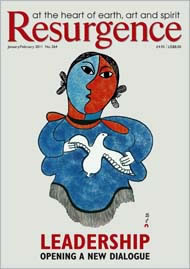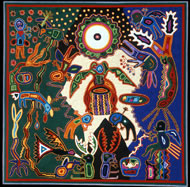Our Elder Brother Kauyumari’s Nierika
This is Tamatsi Kauyumari, Our Elder Brother Fawn of Our Father Sun, with his nierika (the disc at top centre), which symbolises his overwhelming perception. Kauyumari has secured life with it. By passing through the hole in the centre of the nierika, he penetrated to the upper layer of the Underworld and entered the temple-body of his elder brother Deer-Tail, Maxakuaxí, thereby initiating life on Earth. For this purpose, Kauyumari designed nierikate that could reflect everything like a pool of water and also have the quality of penetrating matter, like the holes he carved through the lava stone in the infrastructure of the earth. The first are symbolised in mirrors, and the latter in the holes carved in the centre of round sculptures taken to the power spots of the ancestor spirits or used on the façades of their shrines.
Kauyumari’s nierika also gathers the divine essence of all things, whether in the eastern holy land of Wírikuta, in the central sacred caves of Teacata, or in the western region of Our Mother Sea. Our Ancestors gather in the nierika. Kauyumari is in all regions: the first world of Watetüapa, the Underworld; the second world of Heriepa, the Earth; and the third world of Taheimá, the Sky. In effect, Kauyumari’s nierika embraces the whole world.
We see how Kauyumari functions in rapport with Our Mother Young Eagle Girl, Tatéi Werika Wimari, who is the spirit of the sky embodied in the form of an eagle (at centre). Her head is turned down as she listens attentively to him. She receives the words of Kauyumari, which rest on her feathers – she is their keeper.
Kauyumari is sitting on a rock (bottom right). His words travel along a thread which ends in a prayer-bowl (lower margin). The words unite in the prayer-bowl becoming tukari, life energy (represented as a white flower). These are the words that Kauyumari entrusts to Our Eagle Mother. She is therefore depicted with a shaman’s basket (between her legs at centre) within which she keeps his words. The basket is surmounted by Kauyumari’s antlers, which she receives in her heart.
Our Grandfather Fire, Tatewarí, listens to Kauyumari with the feathers on his head, which are his flames. He is suspended from the edge of the nierika disc (at right), leaning down towards Kauyumari. Tatewarí and Kauyumari are both linked to a shaman’s basket (centre right) because Our Elder Brother Fawn of the Sun is the shaman’s intermediary to Our Grandfather’s wisdom. Tatewarí’s words are depicted as red and blue dots on his fingertips.
Our Father Sun, Tayau, is depicted on the other side of the nierika (centre left). Both he and Our Grandfather Fire reached the edge of the nierika, where they could see Kauyumari disappear in the middle of the disc.
Kauyumari first formed the nierika from foam-covered water. The white in the nierika disc symbolises the white foam; the black circle symbolises Kauyumari’s vision in the darkness of night; the yellow circle symbolises his vision in light; the pink circle symbolises life. Kauyumari’s words are scattered in the space around the disc as yellow dots.
Our Father Sun appears linked to his alter ego in the holy land below as Pariya, Dawn (orange figure to the left of the eagle). This is where Kauyumari’s nierika is located, in the holy land where the sun rises, and so is Our Great Grandfather Deer-Tail’s temple (dark brown domed field, below). Deer-Tail, depicted within the temple with red antlers, is below this realm, as a petrified figure. He is also depicted as a person (opposite the orange figure of Dawn). When Deer-Tail left his body, the temple materialised from his carcass. In the temple behind Deer-Tail is the deified figure of Our Mother of the Sea. A crane brings a calabash gourd to her with fresh water. A prayer-bowl is made from the gourd, like the one in front of Deer-Tail where Kauyumari’s words became life. In fact, Kauyumari himself appeared from Deer-Tail’s dismembered heart-memory. Blue Deer, Maxayuawi, also sprang to life in the form of a deer (at left of centre) from Deer-Tail’s body. Blue Deer was created to give life energy to the votive offerings, so a path connects him to the calabash gourd, because his blood gives life to prayer-bowls. Blue Deer also offers his blood in sacrifice to corn in particular, which is why a corn stalk nurtured by his blood rises up to meet his hind legs (lower left margin).
The green path above Blue Deer is a vein of sacred water that feeds the soul. Our Father Sun’s prayer bowl lies just below Our Grandfather’s flames (above Blue Deer) and next to the water stream. Our Father Sun, by means of his memory, which is in the bowl, and Our Grandfather Fire, through his flames/feathers, remain in agreement.
Watákame, the first cultivator of the fields (seen at top left), was also a companion of Our Ancestors, although he performed his deeds after life had become firmly rooted on Our Mother Earth. So he, too, is depicted, albeit in the distance, around Kauyumari’s nierika. Two gourds for water hang from his neck, and flowers surround him, symbolising words that he does not master. A sheep is depicted facing Watákame. Its blood was first shed to allow Kauyumari’s words to rest. The plumed arrow, muvieri, atop the sheep’s head attracts Kauyumari’s words. This symbolic arrow embodies the spirit of the sacrificed lamb, which passes from its head.
The rock on which Kauyumari sits is in Xapaviyemetá, where the rain first lifted into the sky. The serpent above Kauyumari (right margin) is the rain which springs from a tree and rises into the breeze, becoming Xapaviyeme (the figure at top right), the Spirit of Rain in the South. Xapa, the wild fig tree, embodies rain giving life to all the ancestor spirits and it nurtures Kauyumari (seemingly through its roots).
For more information visit: wixarika.mediapark.net/







